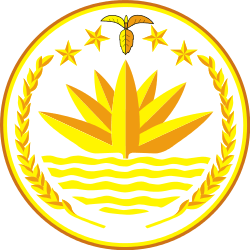Bangladesh–Taiwan relations
 |
|
Taiwan |
Bangladesh |
|---|---|

Taiwan and Bangladesh Relations refer to international relations between Republic of China (Taiwan) and Bangladesh. Taiwan and Bangladesh do not have official relations.
History
On October 4, 1975, Bangladesh recognized the People's Republic of China and ended diplomatic relation with Taiwan.[1] In United Nations General Assembly Resolution 2758 Bangladesh supported the replacement of ROC by the PRC.
In 2004, the Taiwan government established the Taipei Economic and Cultural Office in Bangladesh in, the capital, Dhaka, but due to the Bangladesh government's obstruction, it was unable to offer visa services, leading to its closure on 30 June 2009.[2] Since the Office's closure, Bangladesh affairs have been jointly handled by the Taipei Economic and Cultural Center in India in New Delhi and the Taipei Economic and Cultural Office in Thailand in Bangkok.[3]
Visa policy
Under the visa policy of Bangladesh, Taiwan citizens with Republic of China Passport can be issued visas on arrival, but under the visa policy of Taiwan, Bangladesh citizens now have to obtain visas in New Delhi or Bangkok.[4]
Economic relations
The main export products from Taiwan to Bangladesh are Petroleum, stain steel, synthetic fiber, vinyl chloride, polyacetal, epoxy, cloth and sewing machine. And from Bangladesh to Taiwan are crabs, shrimps, copper, clothing and shoes.[5]
There are over 40 Taiwanese companies investing in Bangladesh, the largest categories are clothing manufacture, shoe manufacture, aquaculture, furniture manufacture. Companies of shoe manufacture are mostly in Chittagong, and others are in the suburban side of Dhaka.[6]
The biggest Taiwanese investor in Bangladesh is Run Xing Textile Company(潤興紡織), and the second is Pou Chen Corporation, which makes running shoes for Nike, Adidas and Puma.[7] After wages increased in China and 2014 Vietnam anti-China protests, many of Taiwanese companies have decided to move their factories to Bangladesh for lower payment and stable environment.[8]
References
- ↑ The Cambridge Handbook of Contemporary China, Colin Mackerras, Amanda Yorke, Cambridge University Press, 1991, page 151
- ↑ Foreign ministry closes its rep office in Bangladesh, The China Post, July 1, 2009
- ↑ Asia Pacific Area, Bureau of Consular Affairs, Ministry of Foreign Affairs (Republic of China)
- ↑ "孟加拉 - 外交部領事事務局全球資訊網". boca.gov.tw. Retrieved 11 August 2015.
- ↑ Trade Profile of Taiwan and Bangladesh by the Ministry of Economic, ROC
- ↑ "Taiwan Trade Center, Dhaka - 投資孟加拉Q&A".
- ↑ "台商網 - 孟加拉 - 投資環境簡介". nat.gov.tw. Retrieved 11 August 2015.
- ↑ Jing Mao Tou Shi: The light of Taiwan in Bangladesh

